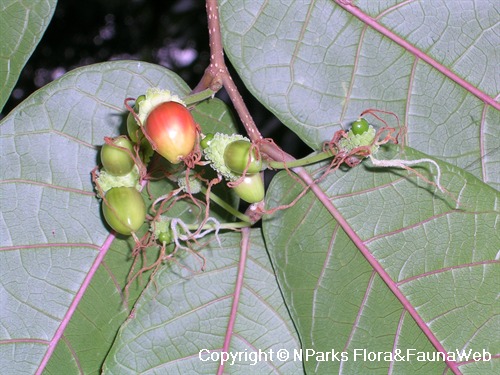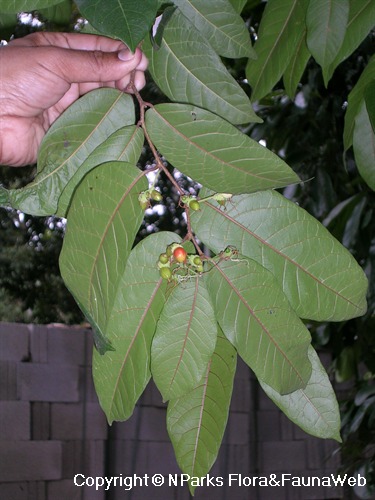
Back
Trophis scandens
| Family Name: | Moraceae |
| Synonyms: | Malaisia scandens |
| Common Name: | Burney Vine, Burny Vine, Fire Vine |
Name
Classifications and Characteristics
| Plant Division | Angiosperms (Flowering Seed Plants) |
|---|---|
| Plant Growth Form | Climber, Shrub |
| Mode of Nutrition | Autotrophic |
Biogeography
| Native Distribution | South China, Indochina, Thailand, Australia, New Caledonia, Fiji, Sumatra, Malay Peninsula, Borneo, Java, Philippines, Celebes, Moluccas. |
|---|---|
| Native Habitat | Terrestrial |
| Local Conservation Status | Native to Singapore (Critically Endangered (CR)) |
Description and Ethnobotany
| Growth Form | It is a climber or shrub with climbing branches. |
|---|---|
| Foliage | Leaves are narrowly elliptic to ovate (4 – 20 cm long and 1.5 - 8 cm wide), distichously arranged and usually asymmetric. Leaves have acuminate apex acuminate and rounded to subcordate base. Upper surface is minutely covered in white hairs on the lower part of mid rib, while the underside of the leaves is hairy on the entire mid rib. Secondary veins form loops inside the leave margin. Stipule is covered sparely in white hairs and may fall off early. |
| Flowers | Male flowers occur in solitary or in pairs or up to 6 on a spike (about 0.5 - 5 cm long). It comprises of anthers (about 0.8 mm long), stamens (about 2.5 mm long) and hairy ovate bracts (0.5 – 1 mm long) that are basally attached. Female flowers are borne in solitary globular heads (0.3 – 0.5 cm diameter) or in racemes. There are usually 2 - 4 fertile flowers per head. It comprises of ovary (1 mm long), style (1 – 2 mm long), protruding stigma (0.5 – 1.5 cm long) and hairy ovate bracts that are basally attached |
| Fruit | Fruit is ellipsoid (about 0.6 – 0.8 cm long) and turn dark pink to red at maturity. |
| Habitat | Found in forest edges, floodplain forest, sometimes on limestone at altitudes up to 1300m. |
| Ethnobotanical Uses | Food (Fruit or Vegetable): Mature fruits are eaten raw. |
Landscaping Features
| Landscape Uses | Parks & Gardens |
|---|
Plant Care and Propagation
| Light Preference | Full Sun |
|---|---|
| Water Preference | Moderate Water |
Foliar
| Mature Foliage Colour(s) | Green |
|---|
Fruit, Seed and Spore
| Mature Fruit Colour(s) | Orange, Red |
|---|
References
| References | Berg, C. C. & E. J. H. Corner. 2005. Ficus subgenus Ficus. Flora Malesiana, Series I. 17(2): 71–136 |
|---|
Image Repository
Others
| Master ID | 230 |
|---|---|
| Species ID | 1526 |
| Flora Disclaimer | The information in this website has been compiled from reliable sources, such as reference works on medicinal plants. It is not a substitute for medical advice or treatment and NParks does not purport to provide any medical advice. Readers should always consult his/her physician before using or consuming a plant for medicinal purposes. |


